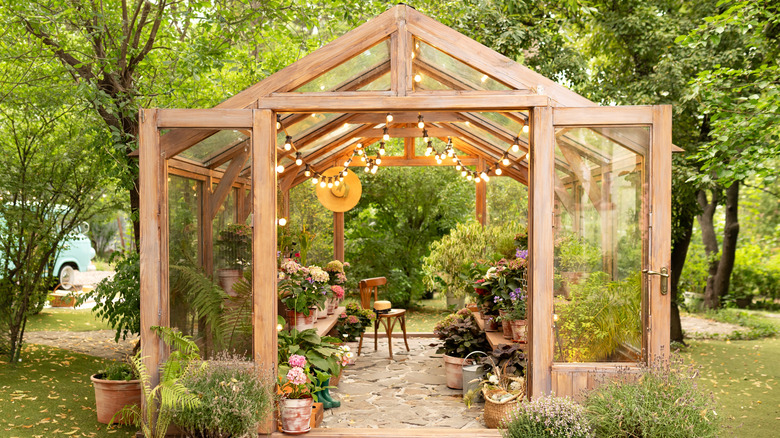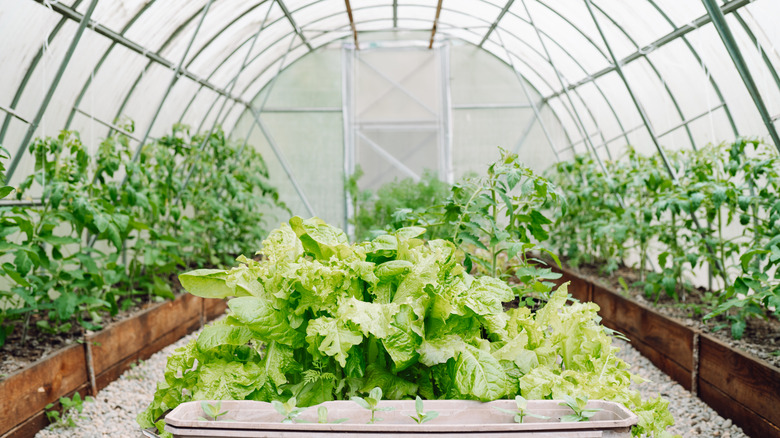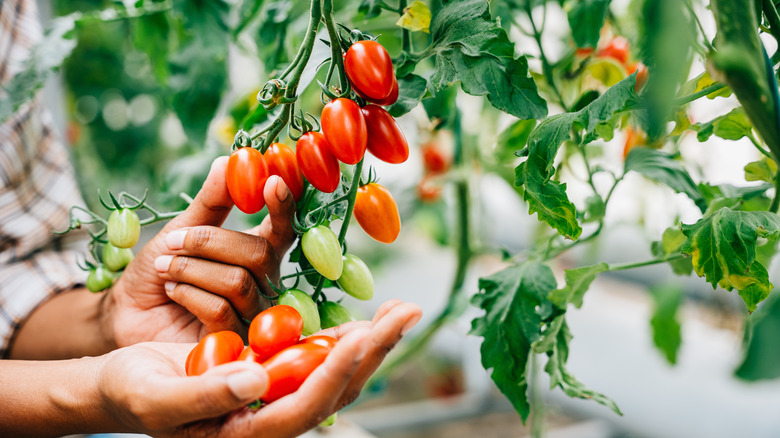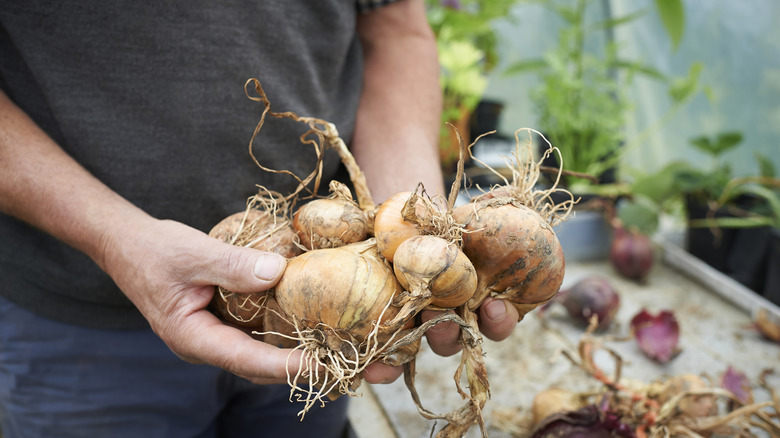The Best Plants To Grow In Your Greenhouse

There are so many plants in the world, coming in all shapes, sizes, and colors. Depending on where you live, though, sometimes it feels like you are very limited as to what you can and can't plant. Fruits and vegetables either have a rather short growing season or simply don't thrive at all. Greenhouses can help a little, but you have to know what plants grow best in one. While technically you could plant anything in a greenhouse, some have more specific needs or don't do well without plenty of ventilation, making them hard to take care of in an enclosed space.
Thankfully, there are quite a few plants that enjoy the consistency and warmer temperatures of a greenhouse and are easy to grow in these conditions. Fruit trees, garlic, tomatoes, cucumbers, leafy greens, and beautiful ornamental plants all do well in a greenhouse with regular care.
That's not to say gardening with the assistance of a greenhouse is any easier than gardening in a normal bed. While disease and pests may be reduced, the constant monitoring of temperatures and humidity and the need to pollinate some of your own plants (unless they're self-pollinating) means you'll stay just as busy. Since greenhouses extend your growing time by two months or more, you'll also be busier for more of the year. Instead of just a month or two of harvesting, you'll be looking at taking care of plants possibly year-round, depending on the kind of greenhouse you get, the plants you choose, and your climate. But all of this hard work is worth it when you have the chance to grow more produce for you and your family and you get to grow plants you'd otherwise never be able to in your USDA hardiness zone.
Read more: 5 Ways To Make Your Home Garden Repel Ticks And Fleas
Fruit Trees

Fruit trees can get pretty big. Thankfully, you don't have to keep them in your greenhouse their whole life. Instead, consider it a place to help them get started, especially if you are growing them from seed and not a nursery. Keeping them sheltered for a while will keep pests away and allow them to grow in a warm, safe environment. Once they are durable and able to handle fluctuating temperatures, you can consider transplanting them outside.
Of course, if you're trying to grow a fruit tree that wouldn't normally do well in your zone, you can also just leave it in there to thrive. It takes a little extra work but is entirely plausible, especially if your greenhouse is large enough to handle its growth. It's also a wonderful option if you tend to have a lot of wildlife in your area, as it keeps your fruit safe for you, and prevents pests like deer and squirrels from getting to the products of your labor before you do. Additionally, you should generally reconsider planting a fruit tree if you live in bear country , but greenhouses can help mitigate several of these issues if done correctly.
Some of the fruit trees you can grow in a greenhouse without many issues include figs and citrus varieties. You can also plant fruit bushes or vines without much of a problem such as strawberries, blueberries, and melons. Before you get started, it's a good idea to research how to care for fruits in a greenhouse, as they are a little pickier and require rather specific soil, airflow, and water levels. If these needs aren't met, your fruit trees won't grow fruit .
Leafy Greens

Growing your own leafy greens is one of the ways gardening can be good for your health , as they keep maximum nutrition when picked and eaten within a short window. Leafy greens include any plant made up primarily of edible and green leaves including microgreens, collards, cabbage, lettuce, arugula, bok choy, mustard greens, and endives.
Since leafy greens are generally plants you grow in cooler weather, you may be surprised that they do so well in greenhouses. However, they are very adaptable plants: Not only can you grow them in a greenhouse, but they are excellent choices for hydroponics and work as one of the plants to grow on a stunning plant wall for your backyard . Growing leafy greens in a greenhouse allows you to extend their harvesting season and potentially get fresh greens all year long.
The warm air will push these plants to grow faster, meaning you can harvest more throughout the season and start using these plants in your kitchen sooner than if you planted them outside. However, while you want the warm air from the greenhouse, you'll have to take care that it doesn't get too hot. Generally, once temperatures start staying around 80 degrees Fahrenheit or so, they are more likely to bolt (prepare to flower), making them inedible the rest of the season. Thus, keeping an eye on the temperature is necessary. Generally, as long as you don't plant them in the summer, you should be fine, but if you experience several sunny and warm days out of season, it may be worth keeping a few windows open or adding fans at the hottest parts of the day.
Nightshade Fruits And Vegetables

The nightshade category includes plants like peppers, potatoes, eggplants, and tomatoes. They are classified by their high alkaloid and capsaicin levels. While cucumbers are not a nightshade, they can also get many of the benefits listed below, as they have similar pests, diseases, and growing conditions. The biggest benefit to using plants like potatoes and tomatoes in a greenhouse is keeping away pests. Anyone who has tried to grow any nightshade vegetables outside in a garden understands how difficult it is to keep certain crop-destroying insects far away. While there are plenty of plants that will repel pests from your garden naturally , using a greenhouse is an even more effective method.
There are also many other classic benefits to growing nightshade vegetables in a greenhouse, such as getting to harvest them sooner thanks to warmer, more controlled temperatures providing longer growing seasons where your plants also produce more. The risk of your vegetables getting a deadly disease like tomato blight is also greatly reduced, though not completely preventable. Another benefit is you can try different varieties of these plants. Instead of going with common species of potato, for example, you can try varieties that might not have worked in your zone, such as Blossom and Russian Banana fingerling potatoes.
Growing your nightshades (and cucumbers) in a greenhouse helps, but you still need to be attentive. Pests and fungal spores can slip into open windows and doors. In enclosed conditions, they can quickly cause havoc. Because of the smaller space, it's easier for them to infect or destroy produce faster than they would outside. Be sure and check your plants regularly, and don't be afraid to toss out any that show signs of diseases.
Alliums

Alliums are a group of vegetables including onions, chives, leeks, shallots, and garlic. They are delicious, beneficial plants that are perfect to keep in your home year-round. Unfortunately, sometimes they tend to start sprouting right on your counter if you don't use them quickly enough. Though you can still eat them this way, the flavor changes to the point that it may not enhance a dish the way you want it to. Instead of throwing them in the trash or trying to hold on to them until the perfect season for planting, just throw them in the soil any time of year if you have the right tool and space.
For most alliums, the greenhouse is perfect, as they can get plenty of sunlight and keep warm soil. However, garlic is a bit of a different problem. In general, this allium needs colder temperatures to encourage the bulbs to open. If your greenhouse stays too warm, you're more likely to end up with rotten garlic than edible plants. If your greenhouse still drops to about 40 degrees Fahrenheit for several nights, there is a variety known as hardnecks you can plant in your greenhouse. However, if it is already warmer, even at night, the softneck garlic can withstand somewhat warmer temperatures.
While you can plant alliums in a greenhouse, there are also perks to having a few outside with the rest of your beds. For example, garlic in your garden keeps certain pests far away . When the weather is right, plant or transplant a few bulbs outside to keep annoying insects at bay. The rest of your alliums can sit right in the greenhouse.
Ornamental Plants

Ornamental plants are ones primarily planted to catch the eye. They may have other (sometimes unplanned) benefits, such as attracting pollinators or housing and feeding wildlife. But generally, they are valued more for their looks than anything else. Native ornamental plants are available in pretty much any USDA zone. In these cases, you can plant them directly in your garden to make your space feel even more inviting.
However, sometimes there are plants you really want to grow that just don't do well where you live. Perhaps you even bought one, only to realize when you got home that it was almost impossible to keep alive outside. If you've found a plant you're in love with but you don't live in the right climate for them, growing them in a greenhouse is the perfect option. If you maintain high humidity levels and temperatures, you will have the chance to keep these plants thriving. Sure, they might not make your garden bright and colorful, but you can harvest them later for vases, or dry them and hang them around the house. They can also just bring a burst of happiness when you walk into your greenhouse and see them there waiting for you, sometimes year-round.
Some examples of ornamental plants you can grow include calla lilies, succulents of all shapes and sizes, ferns, poinsettias, and pansies. You could even go a little wild and grow plants like Venus fly traps (if you're willing to feed them), cacti, and orchids, as long as you're able to spend time trying to figure out the precise conditions they like.
Read the original article on Outdoor Guide .
Post a Comment